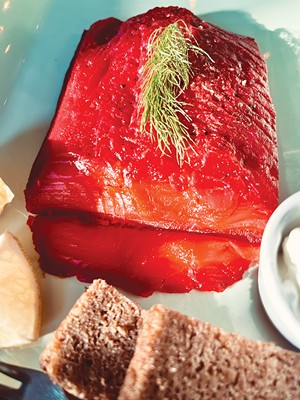The holidays are a time for family and friends to gather and enjoy delicious food. Unfortunately, far too often, over-ambitious baking and meal preparation turn this joyous time into a stressful kitchen marathon. One year I decided to make a classic pâté en croûte, a terrine of ground pork and duck encased in a pastry crust. It was a real showstopper, but it contained 20 ingredients and I didn't finish making it until 3 a.m., leaving me too sleep-deprived to enjoy the holiday celebration.
I'm older now and I hope wiser, and I realize that spending quality time with family and guests is far more important than exhausting myself making elaborate food. I still want things to be nice and there are plenty of delicious recipes to choose from that are not labor-intensive. One of my favorites is gravlax, a cured salmon dish. I make it every year for Christmas and New Year's. It's easy and quick to prepare at home and costs about half of what store-bought would. Purchasing gravlax from a high-end purveyor will run between $50 and $60 a pound. You can buy sashimi-grade salmon for $20 to $30 per pound and make your own gravlax in under 30 minutes, not counting the two-day curing time.
Gravlax has an interesting history. Its origin can be traced back to the 14th century in northern Sweden. Before refrigerators and freezers, fish that needed to be saved for any length of time had to be prepared in some way to keep it from going bad. Swedish fishermen developed a unique form of preservation: burying fish in the sand. Gravlax means "buried salmon." The summer's harvest of salmon would be gutted, fileted, coated with salt and sugar, wrapped in birch bark, weighted with stones, and buried on the beach above the high tide line where it would ferment slowly for several months in the icy winter. As can be imagined, merely salting and fermenting the salmon could result in something that smelled funky and wasn't particularly appetizing. To make it more palatable, dill and conifer needles were added, along with a sprinkling of the Scandinavian liquor Aquavit.
In modern times, fermenting salmon in a hole on the beach is no longer part of the production process. Nowadays, the salmon is "buried" in a dry marinade of salt, sugar and dill, and cured for a few days in the refrigerator. The salt and sugar, helped by the application of pressure, draw out water from the fish through osmosis. As the salmon cures, the moisture that is released turns the dry cure into a highly concentrated brine which wards off bacteria that would otherwise hasten spoilage, because bacteria need moisture to survive. The curing process also changes the salmon's texture, making it denser and easier to slice into thin sheets. Salmon has a high fat content, and the fat keeps it from seeming dry even when most of the natural moisture is removed. Fresh dill and lemon zest delicately impart additional flavors. The inclusion of alcohol helps unlock flavor compounds from the salmon's fat cells.
To make your own gravlax, look for center-cut salmon filets, which come from the thicker portion of the filet. Don't buy filets without the skin. Leaving the skin on makes slicing much easier. The general formula for the cure is equal parts, by weight, of salt and sugar. The salt and sugar combined should equal half the weight of the salmon. Only use kosher salt or fine sea salt; do not use iodized table salt. Different brands of salt vary in particle size so if you don't have a kitchen scale and are measuring by volume, you'll use more Diamond Crystal kosher salt than Morton kosher salt or fine sea salt.
Beet-Cured Gravlax
The addition of grated beet to the curing process imparts a rich deep fuchsia hue to the surface of the salmon, providing a spectacular contrast against the orange color of the flesh. Start this recipe three days before you plan on serving.
Active time: about 30 minutes
Total time: 48 hours for the actual curing, plus 12 hours resting time.
Ingredients
1 salmon filet, about 1 1/2 pounds, skin on
¾ cup Diamond Crystal kosher salt (or 6 Tbsp. Morton kosher or fine sea salt. See note below.)
6 tablespoons granulated sugar (see note below)
1 medium red beet, peeled and grated, including juice
1 large bunch of fresh dill, stemmed and roughly chopped
1 tablespoon black peppercorns
1 teaspoon coriander seeds
Zest of one lemon
1 tablespoon vodka (optional)
Note: If you have a kitchen scale, which is preferred, record the weight of your salmon in grams. Multiply that weight by .25 to calculate your amount of salt, and the same to calculate your amount of sugar. For example: if your salmon filet weighs 680 grams, weigh out 170 grams of salt and 170 grams of sugar.
Preparation
Before curing the salmon, rinse and pat dry with paper towels. Run your fingers down the length of the salmon and remove any pin bones with tweezers or needle-nosed pliers, pulling firmly and at an angle to prevent tearing up the meat.
Prepare the cure: Combine the salt and sugar together in a mixing bowl. Put the peppercorns and coriander seeds in a plastic bag and whack with a heavy object. Stir in the grated beet, chopped dill, cracked peppercorns and coriander, lemon zest and vodka.
Line a 13-by-9-inch baking dish with two large sheets of plastic wrap. Orient the first piece vertically and the second sheet horizontally like a cross. Using a spoon, spread about 1/3 of the curing mixture evenly on bottom of the dish. Place salmon on top, skin side down. Spread the remaining of the cure on the flesh side.
Wrap the salmon tightly in the plastic wrap. Place another 13-by-9-inch baking dish (or similar) on top. Weigh it down with cans or a heavy object. Refrigerate for 48 hours, turning the salmon over every 12 hours. At the end of the curing period, unwrap the salmon, gently scrape off the curing mixture and rinse under cold running water. Pat dry with paper towels. Rewrap and rest in the refrigerator for at least 12 hours before serving.
To serve, thinly slice the salmon on the bias, discarding skin. Serve with lemon wedges and thin slices of toast. Leftovers will keep, tightly wrapped in plastic wrap, for two weeks in the refrigerator or indefinitely in the freezer.



















